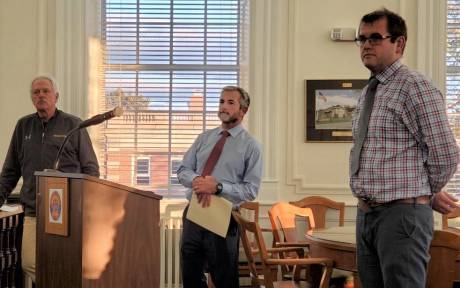Gov. Kathy Hochul at WNY STAMP: Plug Power will get 'the very best people'

Gov. Kathy Hochul touted the hard working Western New York community today as she took part in a groundbreaking ceremony to recognize Plug Power, Inc.’s $290 million investment at the Science & Technology Advanced Manufacturing Park in the Town of Alabama.
“There is a strong work ethic here,” said Hochul, a Buffalo native who spent much time in Genesee and surrounding counties during her days as a U.S. Congresswoman and New York State lieutenant governor. “I come from just a little bit down the road – the granddaughter of a steel worker in a steel plant; my dad worked in the steel plant. In Rochester, he worked at Eastman Kodak and many other jobs.
“People are used to working hard, and employers are recognizing it. This is in our DNA. This is what they will get when they come here and invest here. They’ll get the very best people.”
Hochul was joined by Andy Marsh, chief executive officer of the Latham-based Plug Power, which is set to construct a major green hydrogen fuel production plant and a 450-megawatt electric substation that will provide power to the entire STAMP site.
Officials from the New York Power Authority were also on hand at the Genesee County Economic Development Center-coordinate event, which drew around 100 people.
The NYPA board previously approved a 10,000-kilowatt hydropower provision along with $1.5 million in funding from the Western New York Power Proceeds program, and 143 MW of High-Load Factor power that NYPA will procure for Plug Power on the energy market, drastically lowering electric bills through a reduction in electricity delivery chargers.
Other speakers were State Sen. Edward Rath, Assemblyman Steve Hawley, Genesee County Legislature Chair Rochelle Stein and GCEDC Vice President of Operations Mark Masse.
A CLEAN ENERGY REVOLUTION
Hochul said that the location “is the place where the clean energy revolution is happening.”
She thanked officials at the NYPA for “harnessing the power of the Niagara River … and (being able to) spread that energy across the state – literally, spread the energy across the state.”
“To invest here and to send a message that this project is important enough to have your investment, but also to transfer electricity here and power here, and the conversion into green hydrogen. That’s not happening anywhere else; nowhere else are they being that creative,” she said.
She drew a round of applause when she said, “It’s happening here in Genesee County. And as a result, we’ll have North America’s largest green hydrogen production facility here in the State of New York, but right here in Genesee County.”
The governor said she was “so delighted” to be back home again as this county has special meaning to her.
“I heard Mark (Masse) say I was here a few times,” she said. “I was here a few times a week – to your candy stores and your shops and your restaurants and your downtown, and had the opportunity to talk about the Downtown Revitalization Initiative and so many other transformative projects. So, when I come back home here it gives me the sense of not just (being) excited about what we’ve done in the past but the possibilities in the future. And, ladies and gentlemen, the future is starting today.”
THANKING THE 'EARLY VISIONARIES'
She credited “early visionaries” such as Steve Hyde, former Senator Mary Lou Rath, Assemblyman Steven Hawley, Genesee County Legislature Chair Rochelle Stein and local government officials.
“Thank you for never giving up, for always having the faith. Your persistence and patience has paid off. And that’s what today is all about.”
And she thanked Marsh for seeing the possibilities in Genesee County.
“It’s companies, it’s people and it’s also places, and this place has been crying out for an opportunity like this to show what it was really made out of,” she said. “And the location, I’ve always said this. This region is spectacular because of its proximity to two larger urban areas …”
Masse said interest in STAMP from corporate site selectors from the advanced manufacturing sector -- including semiconductor and clean energy -- has never been stronger.
“There’s a long queue of prospects constantly asking for information, meetings and visiting the site. Our region and our site are very suitable for companies such as Plug Power to succeed and make a lasting impact,” he said.
MASSE PROMOTES SHOVEL-READINESS
Noting that the region has 2.1 million people in a 60-mile radius with 57 colleges and universities – and 4,000 engineering graduates annually, Masse said, “The only thing holding us back now is the increasing of our capacities of existing infrastructure to make this site completely shovel-ready.”
“This would have the full water, sewer, electric at the property line for any company looking to locate here so they can move quickly to construct their facility and be up and running as soon as possible.”
Masse said he was hopeful that New York State will continue to make infrastructure investments to advance the shovel-readiness of mega-sites such as STAMP.
Marsh compared Plug Power’s expansion to George Westinghouse’s pioneering electrical network more than 100 years ago.
“Hydrogen is really important, and green hydrogen is especially important,” he said, adding that projections show that 18 percent of the world’s energy is going to come from hydrogen.
MARSH FORESEES ACCELERATION
“And right here in the field will be the first large-scale green hydrogen network, not only in New York, not only in the U.S., but around the world. Just like George Westinghouse did with electricity years and years ago.”
He called that “a great accelerator for this local economy and Plug Power believes, with its investments here, which we hope to continue to grow – with our investments in Rochester – we will see the same.”
Marsh, mentioning that Plug Power’s green hydrogen will power forklifts at several big companies, said that 25 percent of food during COVID moved through Plug Power products.
“It really made the world realize what Plug Power was doing. We were able to raise $5 billion in the public market, which supplements a lot that goes on with support in New York and other places,” he offered.
CLICK HERE for more about today's developments.


Photo above: Gov. Kathy Hochul speaking at this morning's Plug Power groundbreaking event at WNY STAMP in the Town of Alabama. Photos below: Hochul and Plug Power CEO (center) and other regional and state officials take part in the ceremony; state, regional and local government leaders turned out for the event. Photos by Steve Ognibene.












